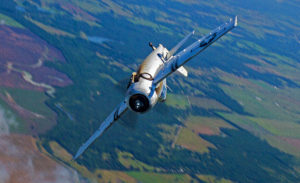Project Description

MPH
WEAPONS
SEATS
General Motors FM-2 Wildcat
Class: Single-seat carrier-borne and land-based fighter and fighter bomber
National Origin: United States
Manufacturer: General Motors
First Flight: 1943
Primary User: United States Navy, United States Marine Corps, Royal Navy, Royal Canadian Navy
Number Built: 4,777
The Grumman F4F Wildcat is an American carrier-based fighter aircraft that began service in 1940 with the United States Navy, and the British Royal Navy where it was initially known as the Martlet. The Wildcat was the only effective fighter available to the United States Navy and Marine Corps in the Pacific Theater during the early part of the Second World War. The FM-2 Wildcat was the General Motors (Eastern Aircraft Division) variant of the Grumman F4F-4 developed from their earlier FM-1. The main differences included the use of the Wright R-1820 engine and an increased vertical fin and rudder. The FM-2 also carried four .50 caliber machine guns as opposed to the six of the F4F-4 and in trade carried 10% more ammunition.
With a top speed of 318 mph, the Wildcat was outperformed by the faster (331 mph), more maneuverable, and longer-ranged Mitsubishi AGM Zero. However, the F4F’s ruggedness, coupled with tactics such as the Thatch Weave and High-side guns pass maneuvers using altitude advantage, resulted in a claimed air combat kill-to-loss ratio of 5.9 in 1942 and 6.9 for the entire war.
Lessons learned from the wildcat were later applied to the faster F6F Hellcat. While the Wildcat had better range and maneuverability at low speed, the Hellcat could rely on superior power and high speed performance to outperform the Zero. The Wildcat continued to be built throughout the remainder of the war to serve on escort carriers, where larger and heavier fighters could not be used. During the production run General Motors would produce almost three times more Wildcats than Grumman.
The General Motors built BuNo 86572 was restored and returned to flight in 2003 under the ownership of Thomas Camp. It joined the museums collection in 2018.
General characteristics
- Crew: 1
- Length: 28 ft 9 in
- Wingspan: 38 ft
- Height: 9 ft 2.5 in
- Wing area: 260 sq ft
- Empty weight: 5,758 lb
- Max. takeoff weight: 7,952 lb
- Powerplant: 1 × Pratt & Whitney R-1830-56 double-row radial engine, 1,350 hp
Performance
- Maximum speed: 318 mph (512 km/h) at 19,400 ft (5,915 m)
- Cruise speed: 155 mph (249 km/h)
- Stall speed: 100 mph (87 kn, 160 km/h)
- Range: 830 mi (721 nmi, 1337 km)
- Service ceiling: 34,000 ft (10,363 m)
- Rate of climb: 2,200 ft/min (11.17 m/s)
- Wing loading: 30.7 lb/sqft (149.77 kg/m²)
- Power/mass: 0.15 hp/lb (249 W/kg)